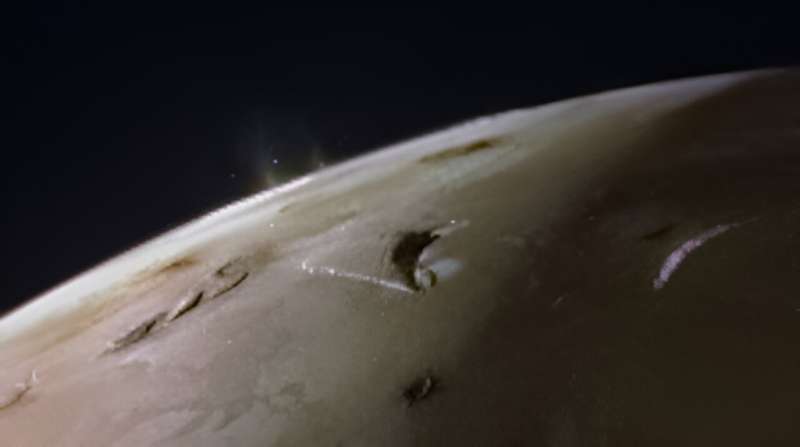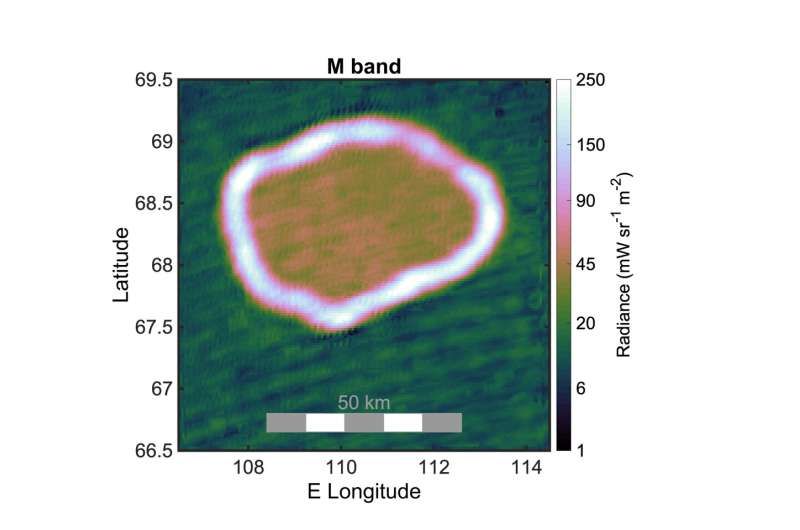
The JunoCam instrument aboard NASA’s Juno spacecraft captured two volcanic plumes rising above the horizon of Jupiter’s moon Io. The image was taken on February 3 from a distance of about 2,400 miles (3,800 kilometers). Credit: Image data: NASA/JPL-Caltech/SwRI/MSSS, Image processing by Andrea Luck (CC BY)
New findings from NASA’s Juno probe provide a more complete picture of the extent of lava lakes on Jupiter’s moon Io and include information for the first time about the volcanic processes at work there. These results come from Juno’s Jovian Infrared Auroral Mapper (JIRAM) instrument, provided by the Italian Space Agency, which “sees” in infrared light. Researchers published a paper on Juno’s most recent volcanic discoveries in Earth and Environment Communications.
Io has intrigued astronomers since 1610, when Galileo Galilei first discovered the Jovian moon, which is slightly larger than Earth’s moon. Some 369 years later, NASA’s Voyager 1 space probe captured a volcanic eruption on the Moon. Subsequent missions to Jupiter, with more flybys of Io, discovered additional plumes, as well as lava lakes. Scientists now believe that Io, which is stretched and compressed like an accordion by neighboring moons and Jupiter itself, is the most volcanically active world in the solar system. But while there are many theories about the types of volcanic eruptions on the Moon’s surface, there is little data to support them.
In May and October 2023, Juno flew by Io, being approximately 21,700 miles (35,000 kilometers) and 8,100 miles (13,000 kilometers) away, respectively. Among Juno’s instruments that got a close look at the alluring moon was JIRAM.
Designed to capture infrared light (which is not visible to the human eye) emerging from Jupiter’s depths, JIRAM probes the weather layer up to 30 to 45 miles (50 to 70 kilometers) below the cloud tops of the gas giant. But during Juno’s extended mission, the mission team also used the instrument to study the moons Io, Europa, Ganymede and Callisto. JIRAM Io imaging showed the presence of bright rings surrounding the ground of many hot spots.
“The high spatial resolution of JIRAM’s infrared images, combined with Juno’s favorable position during flybys, revealed that the entire surface of Io is covered in lava lakes contained in caldera-like formations,” said Alessandro Mura, Juno’s co-investigator. from the National Institute of Astrophysics in Rome. “In the region of Io’s surface where we have the most complete data, we estimate that about 3% of it is covered by one of these molten lava lakes.” (A caldera is a large depression formed when a volcano erupts and collapses.)

Infrared data collected on October 15, 2023 by the JIRAM instrument aboard NASA’s Juno show Chors Patera, a lava lake on Jupiter’s moon Io. The team believes the lake is largely covered by a thick molten crust, with a hot ring at the edges where lava from Io’s interior is directly exposed to space. Credit: NASA/JPL-Caltech/SwRI/ASI/INAF/JIRAM/MSSS
Fire-breathing lakes
JIRAM’s Io flyby data not only highlights the moon’s abundant lava reserves, but also provides insight into what might be happening beneath the surface. Infrared images of several Io lava lakes show a thin circle of lava at the boundary, between the central crust that covers most of the lava lake and the lake walls. Recycling of the melt is implied by the absence of lava flows on and beyond the lake edge, indicating that there is a balance between the melt that erupted into the lava lakes and the melt that is recirculated in the underground system.
“We now have an idea of what is the most common type of volcanism on Io: huge lava lakes where magma rises and falls,” Mura explained. “The lava crust is forced to break against the lake walls, forming the typical lava ring seen in Hawaiian lava lakes. The walls are likely hundreds of meters high, which explains why no observed generally no magma escaping from the pegs”—bowl-shaped features created by volcanism—“and moving across the surface of the moon.”
JIRAM data suggest that most of the surface of these Io hotspots is composed of rocky crust that rises and falls cyclically as a contiguous surface due to central magma upwelling. In this hypothesis, as the crust touches the walls of the lake, friction prevents it from sliding, deforming it and eventually breaking apart, exposing the lava just below the surface.
Another hypothesis remains current: magma arises in the middle of the lake, spreads and forms a crust which sinks along the edge of the lake, exposing the lava.
“We are just starting to look at the JIRAM results from close flybys of Io in December 2023 and February 2024,” said Scott Bolton, principal investigator for Juno at the Southwest Research Institute in San Antonio. “The observations show fascinating new insights into Io’s volcanic processes. Combining these new results with Juno’s longer-term campaign to monitor and map Io’s never-before-seen north and south pole volcanoes, JIRAM proves to be one of the most valuable tools for learning how this tortured world works.
Juno made its 62nd flyby of Jupiter, which included a flyby of Io at an altitude of about 18,175 miles (29,250 kilometers), on June 13. The 63rd flyby of the gas giant is scheduled for July 16.
Correction note (06/27/2024): An earlier version of this article incorrectly stated that Io is slightly larger than Earth; it is actually slightly larger than Earth’s Moon.
More information:
Alessandro Mura et al, Hot Rings on Io observed by Juno/JIRAM, Earth & Environment Communications (2024). DOI: 10.1038/s43247-024-01486-5
Quote: NASA’s Juno probe closely observes lava lakes on Jupiter’s moon Io (June 26, 2024) retrieved June 27, 2024 from https://phys.org/news/2024-06-nasa-juno-probe -lava- lakes.html
This document is subject to copyright. Except for fair use for private study or research purposes, no part may be reproduced without written permission. The content is provided for information only.